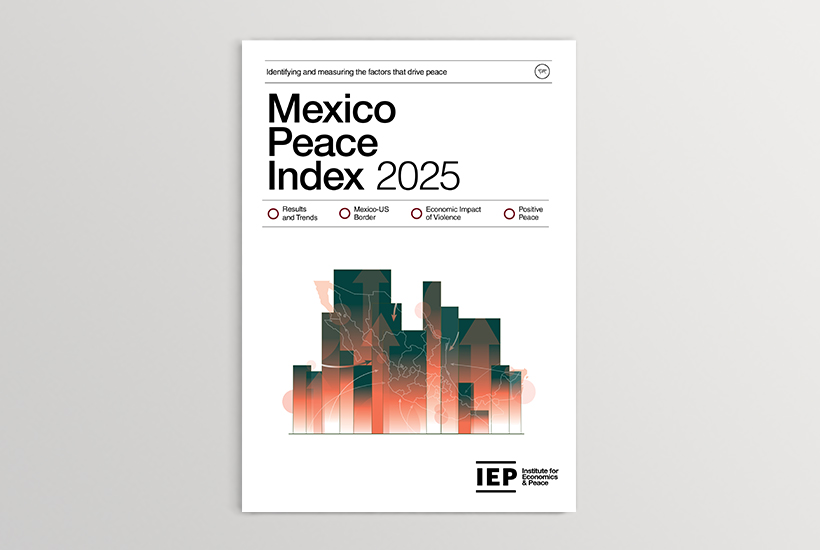Mexico City, May 13, 2025 The Institute for Economics and Peace (IEP) presents the twelfth edition of the Mexico Peace Index (MPI), the most comprehensive data-based analysis of peace, its economic value, violence trends, and Positive Peace in Mexico. The Mexico Peace Index 2025 provides valuable insights for policymakers, business leaders, and civil society organisations seeking to develop better strategies to foster peace in the country.

Download the Mexico Peace Index 2025 report.
The rise in violence in Mexico is strongly tied to organised crime, which has evolved over the past decade in response to changing drug consumption trends in the U.S. market. The shift toward synthetic drugs like fentanyl, up to 50 times stronger than heroin and potentially 2,700 times more profitable, has reshaped criminal operations. Arms and human trafficking have also become lucrative transnational activities, affecting Mexico-U.S. relations.
Although peace has improved slightly in the past five years, Mexico remains considerably less peaceful than in 2015. Organised crime continues to drive extreme violence. Since 2007, the estimated number of organised crime-related homicides has increased sixfold—from about 3,000 to nearly 18,000 in 2024. In the last decade alone, Mexico has recorded over 300,000 homicides.
Mexico continues to underinvest in key areas needed to strengthen peace. As of 2024, the country allocated only 0.7% of its GDP to law enforcement and the justice system, far below regional and international benchmarks.
The economic impact of violence in Mexico is alarming. In 2024, it rose for the first time since 2019, reaching an estimated 4.5 trillion pesos (USD 245 billion), equivalent to 18% of GDP. On a per capita basis, the cost was 33,905 pesos, higher than the average monthly salary of a Mexican worker.
This year’s Mexico Peace Index highlights how organised crime continues to threaten peace in the country, despite slight recent improvements.
Between 2015 and 2024, peace in Mexico deteriorated by 13.4%, with many crime indicators significantly worse than a decade ago. The homicide rate increased by 54.7%, and firearm-related crimes rose by 71.2%.
As noted earlier, 2024 was the deadliest year on record for political figures in Mexico, with at least 201 politically motivated killings.
Femicide cases nearly doubled over the last decade, from 428 in 2015 to 829 in 2024, a 93.7% increase. Likewise, between 2016 and 2020, homicides targeting LGBTQ+ individuals averaged nearly eight incidents per month, totaling 459 cases.
In 2024, the national sexual violence rate fell by 6.1%, while the family violence rate declined by 2.9%. Despite the continued challenges, these were the first recorded improvements since the Index’s inception. This progress is partly attributed to increased women’s political participation and legal reforms aimed at protecting women from violence, wage discrimination, and other vulnerabilities.
Meanwhile, the number of missing people continues to grow. The rising number of mass graves and clandestine burial sites discovered across the country suggests that many of the missing may have been victims of homicide. These cases are particularly prevalent in states like Jalisco and Colima.
In 2024, 18 states improved their scores on the Peace Index, while 14 experienced increased violence. Colima remained the least peaceful state, with more than 100 homicides per 100,000 residents, the highest rate in the country.
Guanajuato, Morelos, Baja California, and Quintana Roo followed as the most violent states. Conversely, Yucatán was again ranked as the most peaceful, followed by Tlaxcala, Durango, Chiapas, and Nayarit. In 2024, Zacatecas showed the most improvement in peace, while Tabasco experienced the greatest deterioration.
Mexico’s 2024 judicial reform, which changed the selection of judges from appointments to popular elections, remains controversial. Critics warn that it significantly weakens judicial independence, potentially resulting in politically motivated rulings and a decline in the rule of law.